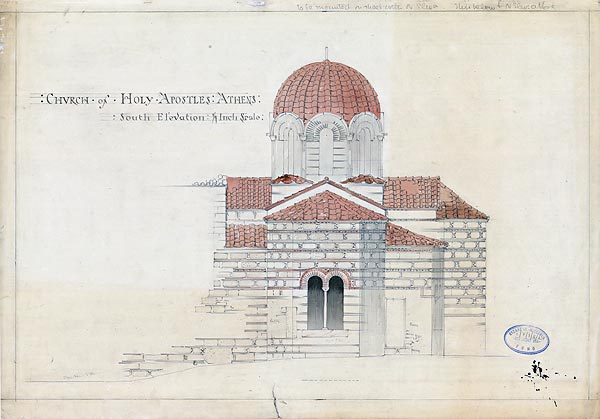About the BRF Collection

The Byzantine Research Fund Archive (BRF) is a unique collection of architectural drawings, photographs and notebooks created from the late 19th century to the middle of the 20th century by a small team of British architects trained in the Arts & Crafts tradition whose studies of Byzantium shaped the Byzantine Revival in later years.
The collection contains over 1,500 drawings and 1,000 photographs, numerous notebooks and the corporate records associated with the Byzantine Research and Publication Fund, the original body created in 1907 to support this work. Although the Fund was associated with the BSA from the time it was founded, it was not until 1937 that the BSA formerly took over the property and operation of it. The BRF Archive contains records of Byzantine monuments in Greece, Turkey, Italy, the Near East, Egypt, and Cyprus. In some cases, the collection contains the only record of a monument before its destruction in modern times, the most important example being the church of Hagios Demetrios in Thessalonike which was almost completely destroyed in the Great Fire of 1917 shortly after being recorded by one of the BRF architects, Walter Sykes George. It also contains personal records of the following architects; Robert Weir Schultz, Sidney Howard Barnsley, Walter Sykes George, William Harvey, Harold Swainson, Peter Gus Corbett, and A.H.S (Peter) Megaw. The aspirations of the BRF Archive Project today are to make these materials accessible to a wide range of researchers.
Transverse section. The drawing is entitled: 'Church at Kaesariani' 'Transverse Section'.
Trasverse section with iconography. The drawing depicts parts of the iconographic program in the naos and the narthex. The wall-paintings in the naos follow the standard Byzantine/post-Byzantine iconographic program/scheme of church decoration. In terms of iconography, they follow well-established 16th-century Cretan School prototypes. They are rather conservative and date to the 18th century. Those of the narthex are less sophisticated with naïve/pictoresque details in the dense composistions. They date, according to a surviving inscription, to the 17th century. The drawing is numbered as follows: 'Attica No 2'. It is entitled in pencil: 'Attica Monastery Church of Kaesariani'. A caption at the bottom reads: 'Church at Kaesariane'. Further annotation in ink and pencil survives.
Longitudinal section. The drawing is entitled: 'Church at Kaisariani: Attica', 'Longitudinal Section'.
Part of transverse section with iconography. The drawing depicts parts of the iconographic program in the dome and the holy bema. The wall-paintings in the naos follow the standard Byzantine/post-Byzantine iconographic program/scheme of church decoration. In terms of iconography, they follow well-established 16th-century Cretan School prototypes. In terms of style, they are rather conservative and date to the 18th century. Those of the narthex are less sophisticated with naïve/pictoresque details in the dense composistions. They date, according to a surviving inscription, to the 17th century. Further annotation in pencil survives.
Transverse section with iconography. The drawing depicts parts of the iconographic program in the naos and the narthex. The wall-paintings in the naos follow the standard Byzantine/post-Byzantine iconographic program/scheme of church decoration. In terms of iconography, they follow well-established 16th-century Cretan School prototypes.. In terms of style, they are rather conservative and date to the 18th century. Those of the narthex are less sophisticated with naïve/pictoresque details in the dense composistions. They date, according to a surviving inscription, to the 17th century. This is a preliminary drawing.
East elevation. Ornamental brickwork appears more emphatically on the east end and the north and south gables of the Kaisariani church. The drawing is entitled: 'Church at Kaesariani' 'East Elevation'.
North elevation. This side is the most elaborately decorated part of the monument. The north arm of the cross is emphasized by a single protruding arch forming a conch-headed recession. The drawing is entitled: 'Church at Kaesariani' 'The North Elevation'.
North elevation. This side is the most elaborately decorated part of the monument. The north arm of the cross is emphasized by a single protruding arch forming a conch-headed recession. The drawing is numbered as follows: 'Attica No 7'. It is captioned: 'North Elevation' and 'Church at Kaesariani'. Further annotation in ink survives.
Ground plan with placement of iconography. The plan depicts the iconographic scheme of the naos and the narthex. The drawing is numbered as follows: 'Attica No -'. It is captioned: 'Church at Kaisariane'. Further annotation in pencil survives.
Ground plan with placement of iconography. The plan depicts the iconographic scheme of the naos and the narthex. This is a preliminary drawing. The word 'Kaisariani' appears in the right-hand corner.
East elevation (detail) - The bema window. Ornamental brickwork appears more emphatically on the east end and the north and south gables of the Kaisariani church. The Drawing depicts the bema window of the church. The window is double of the so-called 'grouped-type': the whole window is embraced in a single arch within which the individual lights are arched separately. The tympanum filling is in curvilinear form: the tile-courses follow concentrically the curve of the subsidiary arches and the individual units are themselves curved. This is one of the best examples of the type. The drawing is captioned as follows: 'Church at Caesariani'. Further annotation in pencil survives.
Bema window and closure slab. The drawing depicts the bema window of the church and a marble closure slab. The window is double of the so-called 'grouped-type': the whole window is embraced in a single arch within which the individual lights are arched separately. The tympanum filling is in curvilinear form: the tile-courses follow concentrically the curve of the subsidiary arches and the individual units are themselves curved. This is one of the best examples of the type. The slab is decorated with foliate and geometrical patterns. Further annotation in pencil survives.
The Tree of Jesse. The Tree of Jesse decorates the west wall of the Kaisariani narthex. The wall-paintings in this part of the church are less sophisticated than those of the naos with naïve/pictoresque details in the dense composistions. They date, according to a surviving inscription, to the 17th century. Made for John, 3rd Marquess of Bute by Gillieron and presented to the Fund by his son (see note in: BRF Corporate Records-List of BRF materials by RWS 1948).
Ground plan. The drawing is entitled: 'Omorfh Ekklesia near Athens - 1/4 Inch Scale - Plan Drawing 1'. Further annotation in pencil surives.
Longitudinal section. The drawing is entitled: 'Omorphi Ekklesia nr Athens - Longitudinal Section - Drwg 2'.
Transverse section. The drawing is entitled: 'Omorfh Ekklesia Section Thro Narthex Looking E Drwg 3'.
Noth elevation. This is a preliminary drawing. It is entitled: 'Omorfh Ekklesia nr Athens - North Elevation - Drawing 4'. Further annotation in pencil survives.
North elevation. The drawing, according to a surviving note, is a copy of R.S. Weir's rough pencil sketch.
East elevation. The drawing according to a surviving inscription, is a copy of R.S. Weir's inked drawing. Further annotation in ink and pencil surives.
East elevation. The drawing is entitled: 'Church at Omorphi - Attica', 'East End'.
East elevation (left) - North elevation (right). This is a preliminary drawing.
North elevation. This is a preliminary drawing.
Ground plan (left), Transverse section (right). The drawing is entitled: 'Phaneromene - Salamis'. Scale which says " 1/8 = 1 ft"
Low relief marble closure slab. Now in Byzantine Museum Athens. The drawing is annotated in pencil: 'Athens Museum?'. See also drawing no.BRF 01/01/01/242
Parts of relief marble closure slabs. Now in Byzantine Museum Athens. See also drawings nos. BRF 01/01/01/242 and BRF 01/01/01/239
Relief marble closure slabs.Now in Byzantine Museum Athens. See also drawing no. BRF 01/01/01/242
Relief marble closure slabs. Now in Byzantine Museum Athens. This is a preliminary drawing. It is annotated in pencil. See also drawing no BRF 01/01/01/241
Relief heraldic slab. Now in Byzantine Museum Athens. The drawing is annotated in pencil.
Preliminary drawing of relief marble closure slabs.The slabs are decorated with crosses surrounded by rosettes, other floral and geometrical motifs and could be dated to the middle Byzantine period. The two slabs decorate the west end (north part) of the church.
Sections of marble epistyles, capitals, pilasters. Now in Byzantine Museum Athens. This is a preliminary drawing. It is annotated in pencil.
Parts of relief marble closure slabs. Now in Byzantine Museum Athens This is a preliminary drawing. It is anotated in pencil. See also drawings nos. BRF 01/01/01/233 and BRF 01/01/01/242
Relief marble closure slab. Now in Byzantine Musuem Athens. This is a preliminary drawing. It is annotated in pencil.
Preliminary drawing of Relief marble closure slabs - Lintel with relief decoration. Now in Byzantine Museum Athens. Further annotation in pencil survives. See also drawing no.BRF 01/01/01/235
Sections of relief marble closure slabs. Now in Byzantine Museum Athens This is a preliminary drawing. It is annotated in pencil. See also drawings nos. BRF 01/01/01/232, BRF 01/01/01/233, and BRF 01/01/01/234.
Sections of relief (closure?) slabs. This is a preliminary drawing. It is labelled in pencil:' Asomaton Monastery". Further annotation in pencil survives.
Sections of vaults and a plan of a soffit. Further annotation in ink survives.
South elevation. This is a preliminary drawing. Further annotation in pencil survives.
Ground plan. The drawing is entitled: 'Plan of a later Greek Church'. Further annotation in ink and pencil survives.
Elevation of dome. The drawing is captioned as follows: 'Elevation of Dome No 2 Type'.
Plan of dome. The drawing is captioned as follows: 'Plan of Dome no 2 Type'.
Plan of dome. The drawing is captioned as follows: 'Plan of Dome no 1 Type'.
Elevation of window. This is a preliminary drawing.
Elevations of windows. The windows belong to Byzantine churches in Athens such as the Hagioi Theodoroi in Klafthmonos square (bottom, right) and the Panagia Kapnikarea (bottom, left) church. Further annotaion in pencil survives.
Window elevations of Byzantine churches in Athens The churches which are represented include: the Hagioi Theodoroi in Klafthmonos square church (top, left-hand corner), the Panagia Kapnikarea (top, right-hand corner), Soteira Lykodemou (bottom, left-hand corner) and the Hagioi Apostoloi tou Solaki (bottom, right-hand corner) church. The drawing is entitled: 'Series of windows from the Byzantine Churches in Athens'. Further annotation in ink survives.
Clockwise from top left: Hagioi Asomatoi at Theseion (Ground plan, South-east elevation), the Taxiarches church (West elevation, East elevation, Ground plan, Longitudinal section), capital from an unidentified Athenian church. Further annotation in ink survives.
Clockwise from top left: Ground plan, West elevation of the church of Hagios Philippos, Ground plan, West elevation, North-east elevation of Megalo Monastiri, West elevation, Transverse section, Ground plan, Longitudinal section of the church of Hagios Ioannis ho Prodromos, Dome plan, Architectural members (mouldings) and Dome elevation of the Panagia church. Further annotation in ink survives.
Clockwise from top left: Ground plan of Soteira Lykodemou, Ground plan of the Greek-cross type, Side elevation of the Greek-cross type, Ground plan of the Megalo Monastiri, Ground plan of Hagioi Apostoloi tou Solaki, Drawings of wallings and of Kufic/pseudo-Kufic friezes. Further annotation in pencil survives.
Ground plan. The ground plan does not resemble that of Hagioi Asomatoi as it is written in pencil in the top right-hand corner of the drawing.
Ground plan. This is a preliminary drawing. Further annotation in pencil survives.
Section of the floor pavement in front of the holy bema (mosaic-marble opus sectile). Further annotation in pencil survives.


